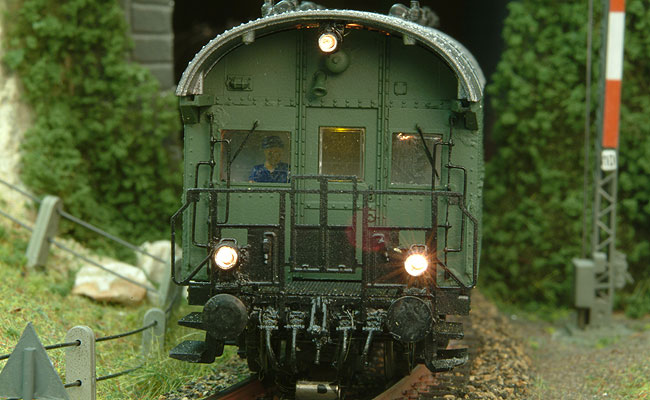Donnerbüchse cab car

The Donnerbüchse are some of Europe’s most well-known carriages. The oldest ones were built at the end of the twenties. Their thundering sound has hard to ignore and they were soon nicknamed ‘Donnerbüchse’ or Thunder Box. After the war the carriages were mainly used on secondary lines, usually in combination with a Br 78 tank locomotive or with a diesel. To reduce the amount of shunting some carriages were converted to cab cars. Unfortunately the cab cars are not available as a model. That is a pity because they really are a great addition to a Donnerbüchse train.

Weinert is marketing a conversion kit to create a cab car from a normal Roco Donnerbüchse. The Weinert Kit consists of several metal parts. They are intended to build a new front and platform on one end of the carriage. The kit also contains spring buffers, a coupling and imitation air hoses. Besides the kit you only need a Roco Donnerbüchse, some paint and glue. An airbrush comes in handy to paint the finished cab car.

Construction
Construction starts with taking the carriage apart. One of the front ends is cut flat and gets a set of extra windows. Please make sure you are taking on the correct front. If you don’t, you will find yourself in the shop ordering a new Roco car (believe me, I know). From then on it is just a matter of putting the metal parts together met super glue. The manual is not very clear. You really have to pay attention to the drawings to figure out what they mean.

The lanterns require extra attention. Weinert did not foresee the lanterns to actually work, but a cab car without front lights is just impossible. I drilled the lanterns up to 1.5 mm hole. That is just wide enough to accommodate an ultra micro light bulb. You can buy these from Conrad (number 720120) or another electronics’ store. The bulbs slide in from the back after the lanterns have been glued to the platform. You cannot connect the bulbs directly to the track. You have to incorporate a 1.5 k Ohm resistor to reduce the voltage.

Digital
I decided to go completely digital and fit the cab car with 60961 decoder from Märklin. The decoder has two function outputs that are direction dependent. These are ideal to power the front lights. The other outputs can be used to illuminate the interior. I added 24 V light bulbs to light the entire car. I also added yellow LEDs in the toilet and the driver’s cabin. Each of them can be turned on and off individually.

I used the four pole Roco couplers to connect the other carriages to the cab car. The couplers provide power for the interior lighting. All cars are illuminated. One of them also features digitally controlled toilet lighting just like the cab car has. I also connected all axles of the train electrically to get a better detection for the blocking system and to reduce flicker of the lights.

The pick-up shoe
The hardest part of this project is adding a pick-up shoe to the cab car. The Roco Donnerbüchse are quite long and have a big overhang on points and in sharp curves. The pick-up shoe under the carriage swings aside and touches one of the tracks causing a short-circuit. The only solution is to use a very small pick-up shoe and put it right under one of the axles. Märklin has such a small pick-up shoe and uses it under their small snow-plough. It is available as spare part number 22 15 67. I constructed a block of styrene around the front axle. The pick-up shoe is glued on top of it. The correct position requires special attention. It will take some moving and bending to get it exactly right. But the result is well worth it!
2003